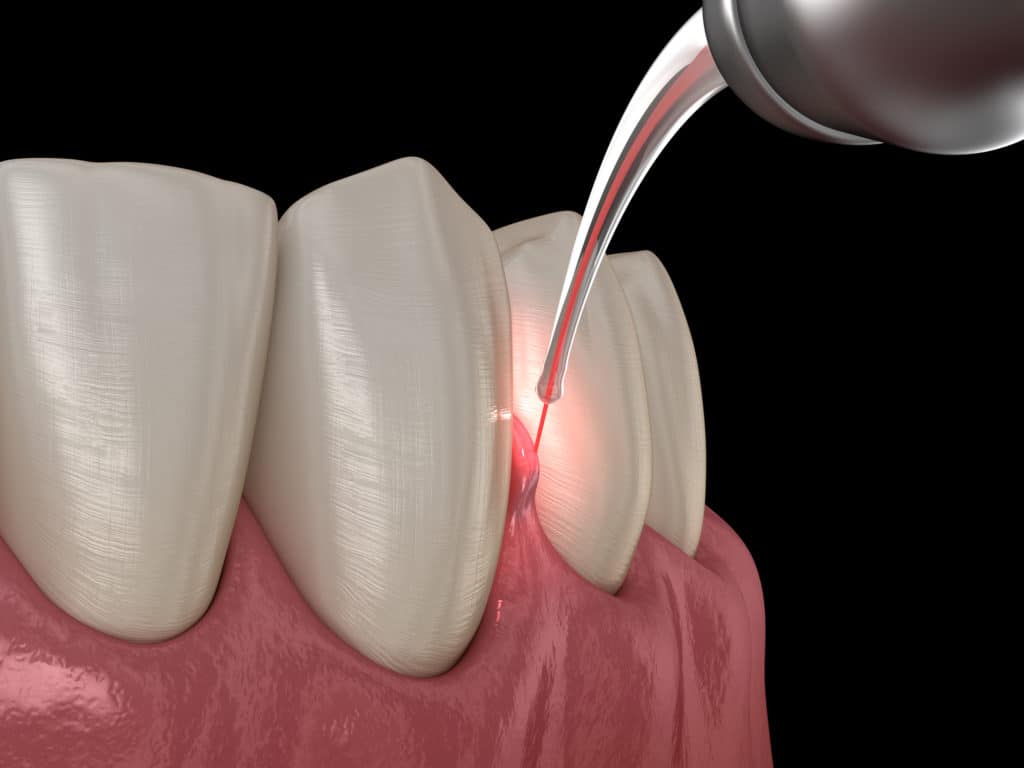
Gum disease, often called the “silent” disease, is one of the leading causes of tooth loss among American adults. Dental professionals refer to this disease as silent because the symptoms usually go unnoticed until the disease has developed into something very serious.
Gum disease has four stages: gingivitis, slight periodontal disease, moderate periodontal disease, and advanced periodontal disease. Gingivitis is the only stage where the disease is reversible. Thankfully, when patients attend regular dental cleaning and exam appointments, gum disease is usually caught in this stage. When patients don’t attend these appointments every six months, the disease is more likely to progress to the latter stages.
In any stage, a laser dentist can provide state-of-the-art, conservative, and effective treatment. Here are five ways our laser dentist treats gum disease and its symptoms:
1. Scaling and Root Planing
Though not a laser treatment, scaling and root planing is the most conservative option when it comes to gum disease. Scaling and root planing is recommended during gingivitis before pockets of bacteria have developed.
This procedure is often called a deep dental cleaning. In addition to a regular dental cleaning, the dentist will remove plaque and tartar from above and below the gum lines. Then, rough spots on the tooth root are smoothed over—this is the planing part. Removing the plaque and tartar gives the gums an opportunity to completely heal.
2. Laser Pocket Decontamination
Lasers provide a conservative and gentle option for patients with gum disease. Rather than using drills and scalpels, our laser dentist utilizes precise dental lasers that emit focused beams into the periodontal pockets. The laser eliminates the bacteria in these pockets, then another laser is lowered to the deepest part of the pocket to remove any remaining aggressive bacteria.
3. Gum Grafts
Gum recession is a common symptom of moderate to advanced gum disease. This exposes the tooth roots, making the teeth more sensitive to hot and cold temperatures. Gum grafts can solve this issue.
The dentist may use grafts from a tissue bank or remove a small amount of tissue from the roof of the patient’s mouth. Tissue removal is completed with dental lasers. Then, the grafts are attached to the gum line.
4. Guided Tissue Regeneration
In this state-of-the-art surgical procedure, our laser dentist uses membranes to regenerate lost gum and bone tissue, creating a healthy and beautiful smile. Without gum regeneration, the teeth and gums would continue to be victims of the disease-causing bacteria which would eventually result in tooth loss.
5. Bone Grafting
Missing teeth also lead to jawbone deterioration. This is why a person who has no teeth often appears to have no jaw. The jawbone needs the tooth roots to stimulate it and keep it strong. Modern technology gives dentists the ability to regrow bone to restore functionality and aesthetics. Once the bone is dense enough, dental implants can be placed to replace the missing teeth.
Austin Laser Dentist
Are you in need of gum disease treatment? Contact our Austin laser dentist today! Dr. Helen Ragsdale has an incredible reputation among patients and other local dentists. She often trains other dentists in laser dental techniques, making her the go-to-dentist for all of your dental needs.
Contact our friendly team today at (512) 346-4690 to receive the gum disease treatment you need.
